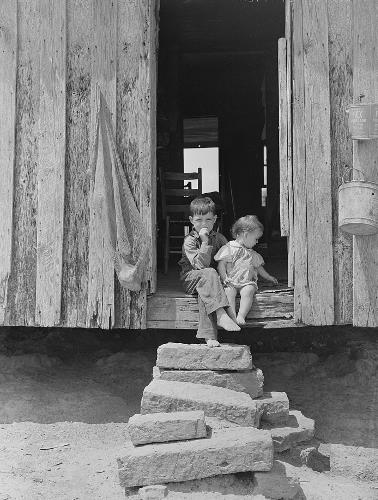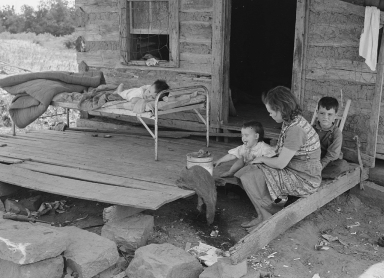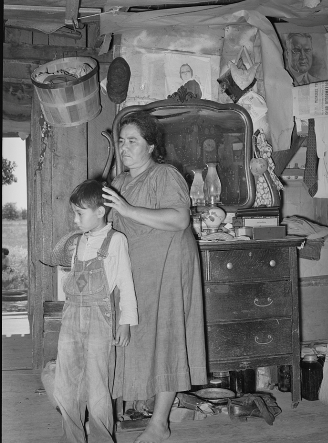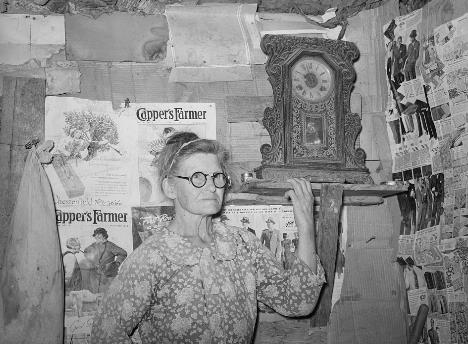
Tenant Farming in Oklahoma
Farming Culture
Agricultural trends in Oklahoma were fundamentally shaped by the political history of the region. In early territorial days, white farmers were explicitly banned from owning land in Indian Territory. Therefore, their only option was to become a tenant, giving them access to the land in exchange for a portion of their crop or a fee paid to the tribal nations whose lands they inhabited, most often the Five Tribes. These tribal lands proved suitable for growing cotton, quickly establishing it as the primary crop in the eastern and southern regions of Oklahoma. Cotton was in high demand and could be stored for long periods , making it ideal for tenant farming communities. Wheat and corn were also grown, but cotton would prove to be the primary driver of tenancy in the state.

A tenant family standing outside of their home near Sallisaw, Oklahoma (image courtesy of the Library of Congress).
Early Indian Territory renting agreements were generally fairly favorable for both parties and gave the tenant a great degree of personal and economic freedom. Although American Indians didn’t believe in personal land ownership, individuals were able to settle a portion of the tribal land for their farm and homestead. Extra land within these plots could be rented to tenants, and, due to the lack of strict ownership laws, contracts tended to be loose and informal. Tenants were encouraged to improve the land and stay in one area for long periods of time, providing stability and a sense of stewardship, if not ownership.

An 1892 map of the Oklahoma and Indian Territories, with a bold red line dividing the two (image courtesy of the Library of Congress).
This changed with the Dawes Act of 1887 and the Curtis Act of 1898, which, in combination, broke up tribal lands and shifted ownership solely to the individual Native landowner, many of whom were pressured or tricked into selling their land to incoming white settlers or speculators. These sales were rife with exploitation and abuse, allowing some wealthy settlers to amass huge land empires for cheap.
These speculators became the early tenant landlords and applied this same savvy, cutthroat business sense to their farming operations, conspiring to keep their tenants poor and powerless. Tenants were pressured to farm as possible, resulting in a shift towards solely growing cash crops. This also led to massive soil depletion, as land was overfarmed and stripped of its nutrients. Regular farm owners felt similarly pressured, if only to support their families and keep up with competition.

Owner and tenant discussing farming practices (2019.061.B1.01267, Oklahoma Conservation Historical Society Collection, OHS).
Tenant farming peaked in the 1910s and 1920s, as an unstable economy and ecological challenges such as droughts made it difficult for small farm owners to hold onto their land, pushing them into tenancy. Tenant farmers faced a number of challenges that prevented them from escaping tenancy and buying their own farm. These included vague one-year leases preventing long-term improvement or cultivation and an unfair credit system marked by high-interest loans. For the next 30 years, census data would show that a majority of all farmers in Oklahoma were tenants, with some having been tenants since their arrival and others falling into tenancy due to economic hardship.
Interestingly, tenancy rates were significantly higher among white farmers than African American farmers, setting Oklahoma apart from the South, where the tenancy system evolved directly out of slavery and disproportionately affected African Americans. Still, despite not being the majority, there were many African American tenants in the state, in addition to American Indians, creating a tenant culture that was uniquely diverse.

African American tenant family on their porch in Wagoner County, Oklahoma (image courtesy of the Library of Congress).
The tenant lifestyle was difficult and unsettled, as families moved extremely often. Homes tended to be extremely poorly maintained, lacking basic necessities such as running water or electricity. Landlords were largely indifferent to these inadequacies, and the tenant themself had little incentive to improve the home or land, as they knew they would soon move on, only to be replaced by a new family with the same mindset. Tenant farmers were forced to plant the same cash crops in the same fields year after year, whereas farm owners had the time and financial freedom to grow a variety of crops, switching fields often to avoid nutrient depletion. Over time, these unsustainable farming practices caused tenant plots to become less productive, forcing tenant families to farm even more intensely to support themselves.
Tenancy also took a psychological toll. Because they were constantly moving, tenant families never had enough time to settle into a home or community, leading to a feeling of isolation. Children were constantly forced to switch schools and were frequently called away from their studies to help with farm labor. Many families couldn’t afford quality food or medicine, leading to malnutrition and disease.

Young children of tenant farmers on their home’s back steps (image courtesy of the Library of Congress).

Oklahoma tenant family on their front porch. According to the photo description, the child on the bed suffers from tuberculosis of the spine (image courtesy of the Library of Congress).
Tenants were not the only people to struggle with poverty, poor living conditions, and other related challenges during this time. Small farmers also had to deal with low prices and the challenges of farm life, in addition to the financial strain of land ownership. However, tenancy promised that these problems would never be solved, as it was nearly impossible for families to hold onto anything, be it land, money, or a sense of home. Their constant mobility kept them from putting down roots that would allow them to gain financial security. A primary and often overlooked role of farm unions and other similar organizations was to provide a sense of community and belonging that tenants often lacked. Additionally, it gave them a feeling of ownership, if not of the land than of the movement in which they participated.

An American Indian mother and son living in a tenant home near Sallisaw, Oklahoma (image courtesy of the Library of Congress).

A widowed tenant in her home in McIntosh, Oklahoma (image courtesy of the Library of Congress).

